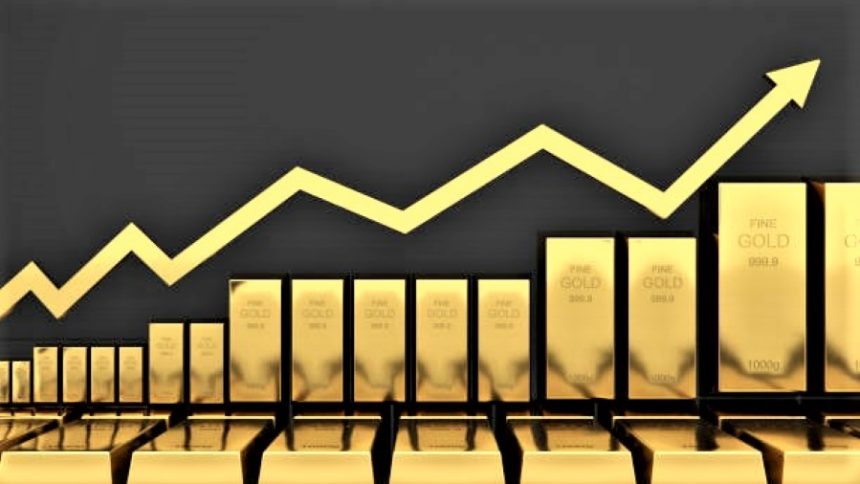Gold Holds Ground Above $3,200 ahead of Rate Cut Bets, Geopolitics, and Dollar Weakness Underpin Strength
Gold prices regained upward momentum early Monday, bolstered by a cocktail of economic, monetary, and geopolitical factors that continue to push the yellow metal into bullish territory. The precious metal opened the week by reversing most of Friday’s losses and pushing past the $3,300 level during Asian trading hours, underpinned by renewed demand driven by a softening US Dollar, rate cut expectations from the Federal Reserve, and escalating global tensions.
Gold Regains Footing After Friday Setback
After slipping slightly on Friday, spot gold (XAU/USD) surged again to reclaim higher ground above $3,300 per ounce. The rebound follows market digestion of the latest US Personal Consumption Expenditures (PCE) Price Index, which indicated softer inflation, reinforcing speculation that the Fed could cut interest rates in the coming months. Traders responded to the data by boosting bets on rate cuts in September and possibly December, weakening the US Dollar and enhancing gold’s appeal as a non-yielding asset.
PCE Data Points to Easing Inflation, Boosting Rate Cut Speculation
Friday’s release of the April PCE Price Index revealed that inflationary pressures in the US are continuing to ease. Headline PCE slipped to 2.1% YoY, marking its lowest level since February 2021, while the core PCE, which excludes volatile food and energy prices, declined to 2.5% YoY from 2.7% in March.
This softening inflationary trend gives the Federal Reserve more breathing room to consider monetary easing. According to CME’s FedWatch tool, market participants now assign a greater than 60% probability to a rate cut in September, with a second cut possible by December.
Fed Officials Signal Openness to Rate Cuts Despite Trade Tariff Headwinds
Adding to the dovish tone, Fed Governor Christopher Waller stated on Monday that rate cuts remain a viable option in 2025—even if Trump-era trade tariffs are reintroduced and spark temporary price increases. Waller’s remarks echo growing sentiment within the Federal Open Market Committee (FOMC) that the Fed can afford to shift toward a more accommodative stance without derailing its inflation objectives.
All eyes are now on Fed Chair Jerome Powell, who is scheduled to speak later Monday. His remarks could provide further clues about the central bank’s future policy path and are expected to have significant implications for both US Dollar performance and gold price volatility this week.
Geopolitical Hotspots Intensify Risk Aversion
Gold’s traditional safe-haven role has also been magnified by escalating geopolitical tensions across multiple fronts.
Ukraine Escalates Drone Assaults Amid Peace Talks
Over the weekend, Ukraine launched one of its largest drone offensives against Russian military infrastructure, striking airfields across five regions and reportedly damaging over 40 aircraft, including long-range bombers capable of carrying nuclear weapons. These strikes come just ahead of the second round of direct peace negotiations in Istanbul scheduled for later today.
While diplomatic efforts offer hope, the simultaneous military escalation underscores the fragile state of global peace and sustains demand for risk-off assets like gold.
Middle East Remains a Powder Keg
Meanwhile, tensions continue to simmer in the Middle East. Israel denied involvement in a deadly incident that killed at least 30 Palestinians, placing the blame on Hamas for allegedly firing on civilians queuing for humanitarian aid. The episode has intensified the war of narratives and fueled uncertainty over whether ceasefire talks will make meaningful progress. This murky backdrop reinforces safe-haven flows into gold.
US-China Trade Tensions Reemerge
In another flashpoint, US-China trade relations are once again in the spotlight. The prospect of renewed tariffs under a second Trump administration has increased market nervousness. While no immediate actions have been announced, the anticipation of more confrontational trade policies could disrupt global supply chains, stoke inflation, and inject renewed volatility into global markets.
The increased trade protectionism is perceived as a long-term inflation risk but also a source of economic instability—both of which support gold’s value as a store of wealth and hedge against policy missteps.
USD Weakness Adds to Gold Allure
The US Dollar Index (DXY) has drifted lower in recent sessions as rate cut expectations have gained traction. A weaker dollar typically boosts gold by making it more affordable for holders of other currencies.
Furthermore, bond markets are starting to price in lower yields, reflecting expectations that the Fed will adopt a more dovish approach. With real yields softening, gold stands to benefit further as the opportunity cost of holding non-yielding assets decreases.
Equity Markets Wobble as Risk Appetite Fades
Equity indices globally have been under pressure amid mixed economic data, inflation fears, and geopolitical unrest. The retreat in equities reflects growing investor caution, driving capital flows toward safer assets such as Treasuries, gold, and the Japanese Yen.
The weakening sentiment in stock markets amplifies gold’s attractiveness, especially as portfolio managers rebalance exposure in light of rising global uncertainty.
Cautious Optimism Ahead of Critical US Data Releases
Despite Monday’s gains, gold bulls remain cautious. Much depends on upcoming US macroeconomic indicators, particularly the ISM Manufacturing PMI, which will offer insights into the state of the industrial sector. A strong reading could pare back some of the Fed rate cut expectations, while a weak report would reinforce the dovish narrative.
Additionally, speeches from other FOMC members this week, including regional presidents and voting members, could create short-term volatility in gold markets. Any surprise hawkish commentary may temporarily lift the USD and limit upside in gold.
Gold Technical Outlook: Key Resistance and Support Levels
From a technical perspective, XAU/USD faces immediate resistance near $3,330, the high reached during the Asian session. A break above this level could open the door toward $3,360 and then $3,400 as bullish momentum intensifies.
On the downside, initial support lies around $3,280, followed by the psychologically important $3,250 level. A breach below $3,200 would negate the short-term bullish outlook and expose gold to deeper corrections.
Momentum indicators such as RSI and MACD suggest the rally is healthy but slightly overextended, which could trigger some consolidation or profit-taking in the near term.
Outlook: Gold Faces Dual Tailwinds from Policy and Geopolitics
As the new trading week unfolds, gold continues to enjoy strong fundamental tailwinds from multiple directions:
- A dovish Fed supported by cooling inflation.
- Geopolitical instability stretching from Eastern Europe to the Middle East.
- Renewed trade war fears amid the US election backdrop.
- A weaker US Dollar and fragile equity markets.
While some short-term consolidation is likely, especially ahead of key US data and Fed speeches, the broader bias for gold remains tilted to the upside. Unless there is a significant shift in either Fed policy communication or geopolitical developments, gold could comfortably sustain levels above $3,200, with bullish targets now extending toward $3,400 and beyond.
[faq-schema id=”39727″]









